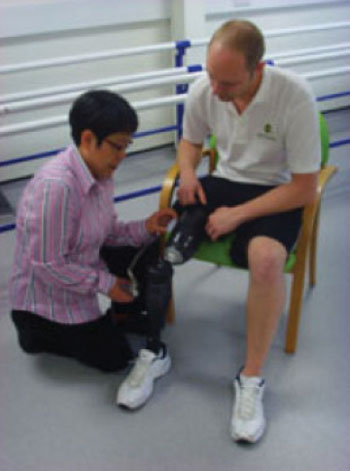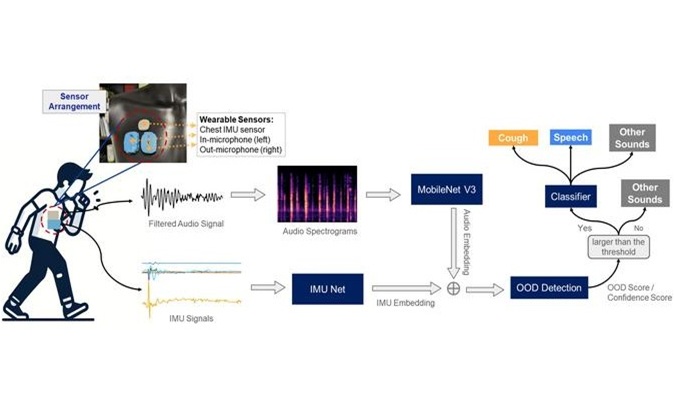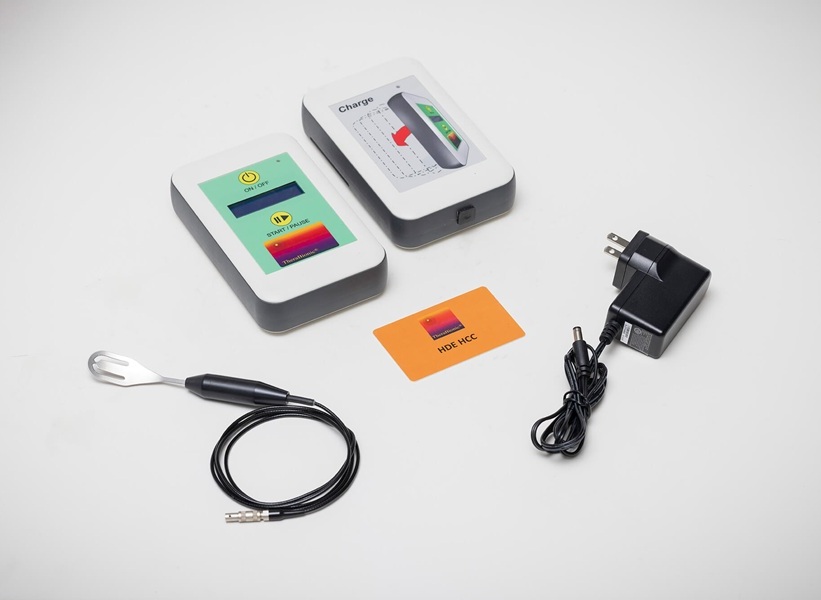Prosthetis Liner Eases Pain in Lower Limb Amputees
|
By HospiMedica International staff writers Posted on 30 Apr 2014 |

Image: Dr. Liudi Jiang fitting the liner to a prosthetic limb (Photo courtesy of the University of Southampton).
A prototype prosthetic intelligent liner with integrated pressure sensors could help relieve the pain and discomfort experienced by amputees due to poorly fitting replacement lower limbs.
Developed by researchers at the University of Southampton (United Kingdom), the novel sensors measure the compression and stretching forces at the interface between a patient's stump and the socket of their prosthesis. When coupled with the liner, the sensors allow clinicians to quickly and accurately assess and optimize socket fit at the outset. A wireless interface will also monitor changes to socket fit over time, alerting patients of the need to adjust their socket or activities to prevent ulcers from forming.
According to the researchers, the relatively practical and potentially low-cost solution could substantially reduce amputees' follow-up visits to rehabilitation centers, giving them a better quality of life, while at the same time reducing healthcare costs. In future, the researchers believe that the technology could form the basis for other intelligent materials, such as shoe insoles to prevent diabetic foot ulcers, or mattresses and wheelchairs that protect against pressure sores in immobile or elderly patients.
“Socket fit is the single biggest factor determining whether prosthesis will be successful for a patient. If we had a simple way to accurately measure the load at the socket-stump interface and determine the best possible fit for that limb, it would completely transform the socket fit experience for amputees,” said Liudi Jiang, PhD, a member of the interdisciplinary team that invented the liner. “We're hoping that the development of the intelligent liner will be the first step leading to the 'holy grail' in prosthetics - a fully automatic, self-adjusting smart socket interface for amputees.”
“This is a tremendously exciting project which has the potential to transform socket technology as a whole in lower limb prosthetics,” said David Moser, PhD, head of research at Chas A Blatchford & Sons (Basingstoke, United Kingdom), which are partnering with the university to develop the sensor into a range of thin prosthetic liners to fit sockets of any shape and size. “We anticipate that from the development of this technology we will reach a new level of understanding and uncover the as yet unclear 'dynamic' qualities of limb loading and socket fit. This step is crucial for the development of the next generation of socket technology products and future artificial limb controls.”
Pain, discomfort, and ulceration are frequently experienced at the socket interface due to poor fit. This stems from the excessive build-up of pressure within the limb socket, causing high loads on the stump. Synthetic liners, worn like a sock over the stump, provide some cushioning against the hard socket, but at present there is no convenient way to accurately measure the critical loads at this interface.
Related Links:
University of Southampton
Chas A Blatchford & Sons
Developed by researchers at the University of Southampton (United Kingdom), the novel sensors measure the compression and stretching forces at the interface between a patient's stump and the socket of their prosthesis. When coupled with the liner, the sensors allow clinicians to quickly and accurately assess and optimize socket fit at the outset. A wireless interface will also monitor changes to socket fit over time, alerting patients of the need to adjust their socket or activities to prevent ulcers from forming.
According to the researchers, the relatively practical and potentially low-cost solution could substantially reduce amputees' follow-up visits to rehabilitation centers, giving them a better quality of life, while at the same time reducing healthcare costs. In future, the researchers believe that the technology could form the basis for other intelligent materials, such as shoe insoles to prevent diabetic foot ulcers, or mattresses and wheelchairs that protect against pressure sores in immobile or elderly patients.
“Socket fit is the single biggest factor determining whether prosthesis will be successful for a patient. If we had a simple way to accurately measure the load at the socket-stump interface and determine the best possible fit for that limb, it would completely transform the socket fit experience for amputees,” said Liudi Jiang, PhD, a member of the interdisciplinary team that invented the liner. “We're hoping that the development of the intelligent liner will be the first step leading to the 'holy grail' in prosthetics - a fully automatic, self-adjusting smart socket interface for amputees.”
“This is a tremendously exciting project which has the potential to transform socket technology as a whole in lower limb prosthetics,” said David Moser, PhD, head of research at Chas A Blatchford & Sons (Basingstoke, United Kingdom), which are partnering with the university to develop the sensor into a range of thin prosthetic liners to fit sockets of any shape and size. “We anticipate that from the development of this technology we will reach a new level of understanding and uncover the as yet unclear 'dynamic' qualities of limb loading and socket fit. This step is crucial for the development of the next generation of socket technology products and future artificial limb controls.”
Pain, discomfort, and ulceration are frequently experienced at the socket interface due to poor fit. This stems from the excessive build-up of pressure within the limb socket, causing high loads on the stump. Synthetic liners, worn like a sock over the stump, provide some cushioning against the hard socket, but at present there is no convenient way to accurately measure the critical loads at this interface.
Related Links:
University of Southampton
Chas A Blatchford & Sons
Latest Patient Care News
- Revolutionary Automatic IV-Line Flushing Device to Enhance Infusion Care
- VR Training Tool Combats Contamination of Portable Medical Equipment
- Portable Biosensor Platform to Reduce Hospital-Acquired Infections
- First-Of-Its-Kind Portable Germicidal Light Technology Disinfects High-Touch Clinical Surfaces in Seconds
- Surgical Capacity Optimization Solution Helps Hospitals Boost OR Utilization

- Game-Changing Innovation in Surgical Instrument Sterilization Significantly Improves OR Throughput
- Next Gen ICU Bed to Help Address Complex Critical Care Needs
- Groundbreaking AI-Powered UV-C Disinfection Technology Redefines Infection Control Landscape
- Clean Hospitals Can Reduce Antibiotic Resistance, Save Lives
- Smart Hospital Beds Improve Accuracy of Medical Diagnosis
- New Fast Endoscope Drying System Improves Productivity and Traceability
- World’s First Automated Endoscope Cleaner Fights Antimicrobial Resistance
- Portable High-Capacity Digital Stretcher Scales Provide Precision Weighing for Patients in ER
- Portable Clinical Scale with Remote Indicator Allows for Flexible Patient Weighing Use
- Innovative and Highly Customizable Medical Carts Offer Unlimited Configuration Possibilities
- Biomolecular Wound Healing Film Adheres to Sensitive Tissue and Releases Active Ingredients
Channels
Critical Care
view channel
Origami Robots to Deliver Medicine Less Invasively and More Effectively
Delivering medicine to ulcers or other internal sites often requires invasive procedures that can disrupt surrounding tissues and lengthen recovery times. Traditional magnetic actuators used in soft robotics... Read more
Improved Cough-Detection Technology Aids Health Monitoring
Coughing serves as an important biomarker for tracking a variety of conditions and can help monitor the progress of respiratory diseases or predict when someone’s asthma is being exacerbated.... Read moreSurgical Techniques
view channel
Novel Glue Prevents Complications After Breast Cancer Surgery
Seroma and prolonged lymphorrhea are among the most common complications following axillary lymphadenectomy in breast cancer patients. These postoperative issues can delay recovery and postpone the start... Read more
Breakthrough Brain Implant Enables Safer and More Precise Drug Delivery
Delivering medication directly to specific regions of the brain has long been a major challenge in treating neurological disorders. Current implants and infusion systems typically reach only one or two... Read moreHealth IT
view channel
Printable Molecule-Selective Nanoparticles Enable Mass Production of Wearable Biosensors
The future of medicine is likely to focus on the personalization of healthcare—understanding exactly what an individual requires and delivering the appropriate combination of nutrients, metabolites, and... Read moreBusiness
view channel
Philips and Masimo Partner to Advance Patient Monitoring Measurement Technologies
Royal Philips (Amsterdam, Netherlands) and Masimo (Irvine, California, USA) have renewed their multi-year strategic collaboration, combining Philips’ expertise in patient monitoring with Masimo’s noninvasive... Read more
B. Braun Acquires Digital Microsurgery Company True Digital Surgery
The high-end microsurgery market in neurosurgery, spine, and ENT is undergoing a significant transformation. Traditional analog microscopes are giving way to digital exoscopes, which provide improved visualization,... Read more
CMEF 2025 to Promote Holistic and High-Quality Development of Medical and Health Industry
The 92nd China International Medical Equipment Fair (CMEF 2025) Autumn Exhibition is scheduled to be held from September 26 to 29 at the China Import and Export Fair Complex (Canton Fair Complex) in Guangzhou.... Read more
















